Plastic Containers, Boxes and Crates – The Definitive Guide (2020)
17 Sep 2019
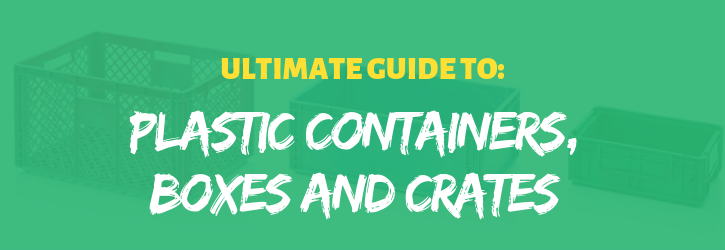
Introduction
The plastic containers, boxes and crates market can be quite mystifying.
There are so many different types;
Plastic pallet boxes – with and without flaps, not to mention the collapsible and ventilated variations.
Then you have spacing saving boxes which equally have many different variations.
Finally you have stacking and Euro containers. These too have their own set of options. Do you require a perforated container? Or do you need one with a lid? What about KLT containers and meat crates?
In the following guide we’re going to try and make sense of all your different plastic box and container options.
Helping you workout which of the many options is best for you and your needs.
So without further ado, let’s get started!
Contents
Chapter 1: The Different Types of Plastic Containers, Boxes, and Crates
Chapter 2: Understand The Different Usage Scenarios
Chapter 3: The Benefits Of Using Containers, Boxes & Crates
Chapter 4: Repair, Reuse & Recycle
Chapter 5: Using Plastic Crates as Moving Boxes
Chapter 6: Conclusion
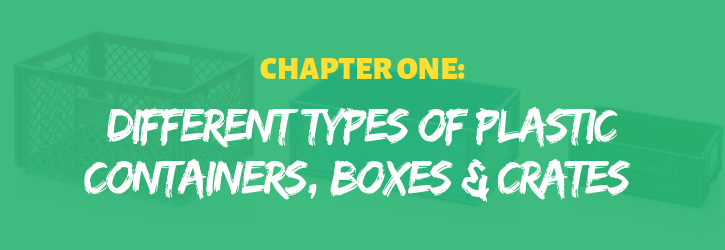
Chapter 1: Types of Plastic Containers, Boxes, and Crates
In this first chapter we’re going to demystify the different types of plastic containers available.
First off its important to understand that plastic containers is a bit of a broad all encompassing term which covers all sorts of different containers, crates and boxes.
In fact you could use the term plastic container to cover all of the following that we’re going to discuss today:
-
Pallet boxes
- Closed Pallet boxes
- Collapsible pallet boxes with flaps
- Collapsible pallet boxes with ventilation holes
- Closed pallet boxes with collapsible sides
- IBC containers
-
Space saving containers
- Folding boxes
- Folding boxes with lids
- Nesting containers
- Nesting containers with lids
- Nesting containers with stacking frames
-
Stacking / Euro containers
- Perforated Euro containers
- Solid Euro containers
- Euro containers with lids
- KLT Containers
- Meat Crates
Pallet Boxes
First up let’s dig into all things pallet boxes.
Before we get into the weeds, here are the different types of pallet boxes we’re going to talk about:
- Closed Pallet boxes
- Collapsible pallet boxes with flaps
- Collapsible boxes with ventilation holes
- Closed pallet boxes with collapsible sides
- IBC containers
Closed Pallet Boxes
Closed pallet boxes get their name from their closed side walls. So whilst they may have an exposed or open top, the rest of the pallet box is completely closed.
They are manufactured from a robust scratch resistance plastic material called HD-PE which results in smoother inner and outer walls. These smooth walls make for easy and efficient cleaning.
Closed pallet boxes ensure high transport safety combined with a comparatively low dead weight.
They are best suited to transporting heavy, large volume packaged goods or can be equally useful as a static storage container.
However it’s important to know that closed pallet boxes themselves come in quite a few variations.
Not only do closed pallet boxes come in different sizes. Some common sizes include;
800 x 600 x 790 mm, 1200 x 1000 x 790 mm and 1200 x 1000 x 740 mm.
You can also get closed pallet boxes with or without kids, feet and wheels.
These make closed pallet boxes very versatile and can be modified to suit lots of different scenarios and situations.
Collapsible Pallet Boxes (Flaps, Ventilated)
Next up is the collapsible pallet box.
Collapsible pallet boxes are great. As the name suggests they have sides which can collapse down out of the way.
However the advantages to this might not be so obvious straight away.
There’s actually a couple key benefits of this system you should know about.
One, as they can be collapsed down to occupy far less space once empty there is a cost reduction on return transport.
Two, as the sides can be completely or partially collapsed down this provides easier access to the contents of the pallet box. This makes the collapsible pallet box very user friendly and reduces the risk of lifting related injuries.
Like closed pallet boxes they’re also made from the robust scratch resistance HD-PE plastic (High-density polyethylene).
You can get collapsible pallet boxes in many variations such as with skids, wheels or feet.
They also come in many different sizes such as: 1200 x 1000 x 1000 mm and 1200 x 800 x 1000 mm.
You can also get collapsible pallet boxes with ventilation holes or flaps. The closed pallet boxes discussed above can also be had in a collapsible variation.
IBC Containers
Next up we have intermediate bulk containers often referred to as IBCs. These are ideal for transporting liquids of all kinds.
They are blow moulded HD-PE container surrounded by a welded steel tube frame which has been galvanised.
They have an inlet on the top for filling and an outlet near the bottom for emptying.
Intermediate bulk containers are reusable and weatherproof with low tare weight fluctuations.
They usually come in 1000 litre capacities as a general rule at 1200 x 1000 x 1160 mm.
Space Saving Containers
We’re now going to discuss and demystify space saving containers.
This will cover the following:
- Folding boxes
- Folding boxes with lids
- Nesting containers
- Nesting containers with lids
- Nesting containers with stacking frames
Spacing saving containers are robust plastic containers which incorporates some kind of design feature which means they can in some way save space, whether that’s through folding or nesting.
Folding Boxes
First up in our space savings container chapter is folding boxes.
Folding boxes save space by (as you have likely gathered) being folded. This brings the top rim of the container to meet the base of the container.
When folded these robust and practical boxes can reduce storage capacity by up to 82%.
They are ideal for transports and consignments and feature a robust folding mechanism.
Typically they will have a closed base and sides in terms of design. Usually featuring open handles and made from polypropylene (or PP for short).
As you may expect Collapsible boxes come in a range of different sizes.
You can get smaller boxes which measures in at 400 x 300 x 220 mm and 400 x 300 x 270 mm.
Alternatively you can get larger Collapsible boxes which come in at 800 x 600 x 440.5 and 600 x 400 x 220 mm.
Collapsible boxes typically come with or without lids. It will depend on your needs whether you want a lidded or unlidded version.
Nesting containers
The other main form of space saving containers are nesting containers.
Nesting or sometimes known as nestable containers are a group of containers which when empty can be stacked into one another.
This stacking functionality offers a fantastic 75% storage reduction.
These versatile nesting containers come in a variety of standard sizes such as:
- 400 x 300 x 320 mm
- 600 x 400 x 220 mm
- 800 x 600 x 320 mm
- 800 x 600 x 420 mm
Nesting containers come in both lidded and non lidded variants. You can also get nesting containers with stacking frames.
Nesting containers with stacking frames can be nested when the frames are in the normal position, or stacked vertically when the frames are in the raised position.
Stacking / Euro containers
We’ve no arrived at our final category of plastic container.
This category is known as the stacking and Euro containers group. We’ll cover the following types of containers:
- Perforated Euro containers
- Solid Euro containers
- Euro containers with lids
- KLT Containers
- Meat Crates
Generally speaking stacking and Euro containers are used all over the world by people who wish to store and send goods in the most effective way.
Euro Containers
Euro containers are hygienic stackable plastic containers.
They are available in a range of popular sizes such as:
400 x 300 x 270 mm
600 x 400 x 320 mm
400 x 300 x 220 mm
A key benefit of Euro containers is that they’re not sensitive to acid or alkali solutions. In fact they’re also resistant to cold and hot temperatures.
Euro containers also feature ergonomic handles to improve manual handling. And are suitable for conveyor systems.
Euro containers are typically made from PP or polypropylene with a closed base, sides and handles.
They are a great transport and storage solution.
You can get Euro containers in a number of styles, which include:
- Perforated Euro container
- Solid Euro container
- With and without lids
KLT Containers
KLT containers are a type of Euro container so called because of their German name Kleinladungsträger (small load carrier) or KLT for short.
KLT containers conform to the VDA (German Association of the Automotive Industry) so are typically used in the automotive industry.
Specifically KLT containers conform to the VDA 4500 standard.
Subsequently KLT containers have been adopted by many other industries and areas of manufacturing and shipping.
As they have to work for the automotive industry KLT containers are resistant to most oils, acids and alkalis.
They can withstand temperatures from -20c to +100c and quietly run on conveyors.
Furthemore KLT containers are fully recyclable and have smooth internal walls which makes cleaning quick and easy.
The feature integrated lid slots and a barcode fixing area.
KLT containers come in a few sizes which include:
400 x 300 x 280mm
600 x 400 x 140.7mm
600 x 400 x 200mm
800 x 600 x 210mm
Meat Crates
A meat crate is a hygienic transport and storage solution for meat and sausage products.
They conform to DIN 55423 and meet the strict requirements of the EHI.
They are optimised for the use of automated logistics such as rollers or conveyor belts.
Any water in the crate is drained from the edge to the outside. It has both closed sides and a closed base but with open handles.
Meat crates are typically 600 x 400 x 200 mm.
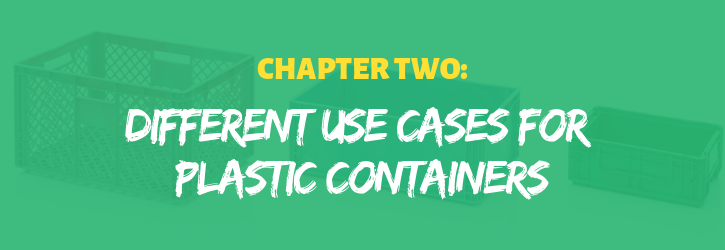
Chapter 2: Usage Scenarios for Plastic Containers
We’ll now investigate and discuss various different use cases. We’ll unearth different ways in which businesses and industries use plastic containers, boxes and crates.
There are about as many uses for plastic containers as there are plastic containers.
Whilst the exact details of usage will vary the main use of a plastic container is the storage or transport of some kind of item or good.
Some popular usage scenarios include:
Storing equipment that needs to be moved on a regular basis. By storing this sort of equipment in plastic containers it allows organisations to be much more efficient and transport their items and equipment seamlessly.
On the flip side you can use plastic containers as a look term storage solution. As they’re so versatile you can use stackable containers to store lots of items without sacrificing too much space.
You can also use plastic containers to organise various things. With plastic containers coming in different colours you can colour code your storage which makes retrieval at a later date that much easier.
However primarily plastic containers are used on large scales in logistic and transport operations.
One of the biggest users of plastic containers is the fruit and vegetable industry. Millions of tons of fresh fruit and vegetables are transported by road around the world every day in plastic crates. In fact fruit and vegetables often spend their own life in a plastic crate. When picked or harvested they will be placed in a plastic crate, then transferred to some other kind of plastic container in distribution centers when they will finally be transported in a plastic container to their destination where they are presented to the customer in a plastic container.
Plastic crates are also commonly used in the dairy industry. As plastic crates are made from high density polyethylene they can stand up to the rigours of the dairy industry where wooden or card alternatives may fail.
Plastic crates can handle automated stacking equipment which is heavily used in industries like dairy. They can also be easily and quickly cleaned so are ideal for transporting and processing milk and other dairy products.
The use of plastic crates is also increasing in the agriculture industry. With plastic crates and containers being so easily cleaned they are a perfect match with the agriculture industry.
Other industries which have quickly adopted the plastic container include the bakery industry, fishing industry and many more.
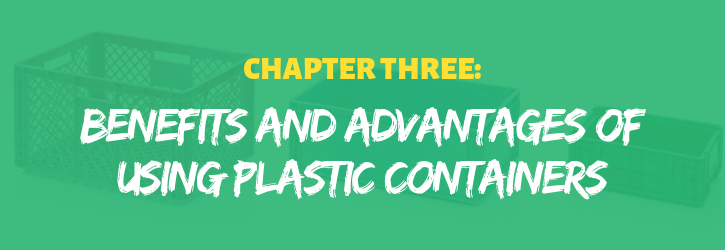
Chapter 3: The Benefits Of Using Plastic Containers, Boxes & Crates
If you’ve made it this far you’ve learnt about the many different types of plastic containers that are available.
You’ve also learnt some ways in which they are used and what industries have adopted plastic containers instead of wooden or card ones.
So we’re now going to discuss all of the advantages of plastic containers and why they are becoming so popular.
The main advantages or benefits of plastic containers are:
- Due to their smooth and lightweight nature plastic containers are much easier and safer to handle than wooden crates which can be heavy and have shards of broken wood.
- Due to the material and manufacturing process plastic containers offer a much wider variety of designs and colours compared to wooden crates.
- Owing to their smooth appearance they are ideal candidates for selling direct to the consumer.
- Plastic containers are lighter and safer to handle compared to wooden products which are heavier and more hazardous. This in turn reduces compensation claims by workers, which reduces insurance costs.
- Plastic containers (depending on the exact version) can be easily stacked on top of each other to save space.
- Ready to go nested plastic crates will occupy less than half the space of a similar number of wooden crates.
- Plastic crates can be safely stored outside without the risk of damage or deterioration.
- Due to the manufacturing process plastic crates are much more uniform than their wooden counterparts.
- Unlike wooden crates plastic containers are incredibly easy to clean and are generally much more hygienic as they’re not a substrate for bacteria, fungus or insect contamination.
- Plastic containers do not absorb water and are immune to acids, facts and solvents. This is particularly important for agriculture, food and pharmaceutical industries.
- Plastic containers are strong and durable and can withstand temperature extremes.
- Minimise the need for costly wood to make repairs.
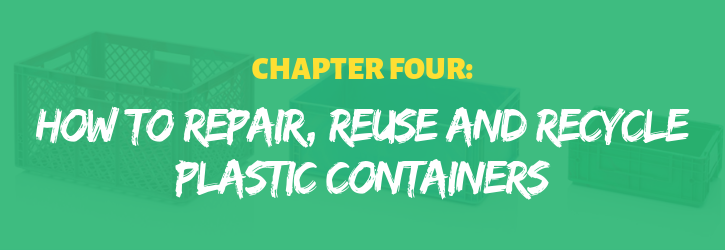
Chapter 4: Repair, Reuse & Recycle Plastic Containers
In this chapter we will discuss how business can prolong the use of their plastic containers. Outlining how they can be repaired, reused and then ultimately recycled.
We’ll also describe some specific tips for preparing plastic containers for recycling and how to generally repair plastic containers.
How to repair
The first stage in the recycling chain is to repair the item in question. If a plastic container can be repaired and put back into circulation than that is a much better solution then discarding or sending to a landfill.
Thankfully plastic containers are very strong and robust to start off with.
However, if they do become damaged they can also sometimes be repaired and put back into use.
You can repair cracks in a plastic container through plastic welding.
Essentially, this process includes melting the plastic material and forming the two edges back together.
When the plastic cools and hardens it will have repaired the crack and can therefore be used again.
How to reuse
Luckily due to the nature of plastic containers there are a million and one ways in which they can be reused instead of being thrown away.
This helps to improve the environmental sustainability of plastic containers. Even if plastic containers are past their best and can no longer be used in a commercial setting there are countless ways they can be used at home.
You could use an old plastic container to store odds and ends in your shed. Or leave outside the front door to stow dirty wellies or shoes.
How to recycle
If your plastic container has reached the end of its life where it is possible to repair or reuse the final option is to recycle.
Luckily plastic containers can be disposed of in an environmentally friendly way.
First, you will need to locate an organisation offering plastic container recycling as a service as they will have the specialist equipment required.
The next stage of the recycling process is for your chosen business to collect your plastic containers.
Once they have them back at their processing facility they will be weighed and sorted into different groups.
Once weighed and sorted they will then be thoroughly cleaned. Luckily it is quick and easy to clean plastic containers as they have smoother robust, scratch resistance surfaces.
Once they have been thoroughly washed they are ready to be melted down.
After the old plastic containers have been melted down they will undergo a process called pelletisation.
This is whereby the melted plastic will be compressed and molded into the shape of a pellet.
These pellets can then be recycled and used to create new plastic containers (or other items).
This is an environmentally friendly way of recycling old plastic containers instead of consigning them to landfills across the planet.
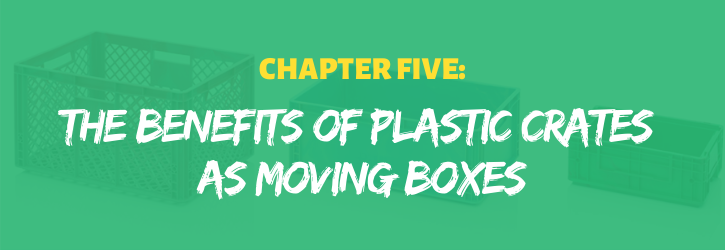
Chapter 5 – The Benefits of Plastic Crates as Moving Boxes
While moving into a new home or office is an exciting time, transporting your possessions from A to B is not. Even if you hire a removal company, it will be your responsibility to pack everything securely. Fortunately, there are several options when it comes to purchasing crates, many of which can be ordered online and delivered straight to your front door.
Cardboard boxes are nothing but trouble. They bend, rip and go soggy in the rain. Put in too much weight and the base will fall out, scattering your goods all over the ground. Although cardboard boxes are the traditional choice when it comes to transportation, plastic storage crates are a great alternative. They are strong, long-lasting, easy to stack, and weatherproof. Here are some of the main advantages of plastic over cardboard.
Cost of Plastic Containers
Cheap cardboard boxes are typically only used once, which means they will need to be replaced almost immediately. Re-usable cardboard boxes are available, but these have a limited life span and will eventually sustain damage or fall apart. Plastic crates are often more economical in the long term as they can be re-used often. If budget is an issue then consider purchasing used crates or looking at rental options.
Assembly and Storage of Plastic Crates
Plastic storage crates are quick and convenient and can be used the minute they are delivered, with no need to assemble them. They can be stacked safely on top of each other when full and nested when empty, taking up far less space than their cardboard equivalents. Cardboard boxes are often delivered flat-packed and it can time-consuming to fold them correctly and tape them to make them more secure.
Plastic crates are also ideal for storage in the home, as they can be stashed under beds or in the wardrobe or can be put in the shed to store outdoor items with no worry about rain damage.
Environmental Impact of Plastic Containers
The environmental impact of both plastic and cardboard is determined by several factors. Either can be environmentally friendly, depending on how the materials have been sourced and whether or not they can be re-used and recycled. Cardboard, of course, has a much shorter life span and there is some evidence to suggest that in the long term it contributes more greenhouse gasses to the environment than plastic.
The durability of Plastic Boxes
Plastic is strong and robust and is ideal for situations where you are transporting valuable or breakable items such as computer equipment or household electricals. Plastic remains sturdier for longer periods of time and holds up to the elements far better than cardboard. Plastic will not be damaged by water and is not susceptible to mould. Cardboard boxes may be cheaper, but they will need to be replaced more often.
While there are financial and environmental arguments for both plastic and cardboard containers, there are few studies that compare the environmental impact of their manufacture. There is a widespread view, however, that it is always better to reuse a product rather than produce a new one.
While both materials are reusable, plastic is stronger, more durable and will last for years. A plastic crate can take 50 to 80 years to decompose, while cardboard boxes are easily damaged and will need replacing frequently.
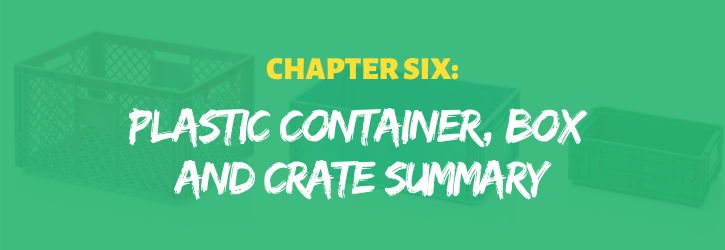
Chapter 6: Conclusion
So there we have it.
Almost everything you could possibly want to know about plastic containers.
We looked at all the different types of plastic container you can get. From plastic pallet boxes, collapsible boxes, collapsible containers and euro containers to more niche items like KLT containers or meat crates.
We then looked at how these different containers are used. Examining specific practices as well as general industry usage.
Next, we identified all of the benefits and advantages that plastic containers provide us. Of which there are many.
Lastly, we examined how plastic pallets can be a sustainable solution. Outlining how they can be repaired, reused and ultimately recycled.
If you have any feedback or think we’ve missed anything then please let us know.
Alternatively, come back later as we’ll continue to make updates to this guide to keep it up to date with all the latest information regarding plastic containers.
